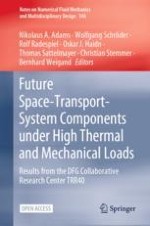The flow of reacting, multicomponent, compressible fluids is governed by the conservation equations of mass and momentum together with the transport equations for the energy and the different involved species. Let
\(\rho \),
t,
\(\mathbf {u}\),
\(\mathbf {\sigma }\),
\(h_t\),
\(\dot{\mathbf {q}}\),
\(Y_k\),
\(\mathbf {j_k}\),
\(\dot{\omega }_k\) and
\(N_c\) represent the density, time, velocity vector, stress tensor, total enthalpy, heat flux vector, mass fraction, mass flux vector, source term and the number of species, respectively. The governing equations read:
$$\begin{aligned} \frac{\partial \rho }{\partial t} + \nabla \cdot \left( \rho \mathbf {u} \right) = 0 \; , \end{aligned}$$
(1)
$$\begin{aligned} \frac{\partial \left( \rho \mathbf {u} \right) }{\partial t} + \nabla \cdot \left( \rho \mathbf {u} \mathbf {u} \right) = \nabla \cdot \mathbf {\sigma } \; , \end{aligned}$$
(2)
$$\begin{aligned} \frac{\partial \left( \rho h_\text {t} \right) }{\partial t} + \nabla \cdot \left( \rho h_\text {t} \mathbf {u} \right) = \frac{\partial p}{\partial t} + \nabla \cdot \left( \tau \cdot \mathbf {u} \right) - \nabla \cdot \dot{\mathbf {q}} \end{aligned}$$
(3)
and
$$\begin{aligned} \frac{\partial \left( \rho Y_k \right) }{\partial t} + \nabla \cdot \left( \rho Y_k \mathbf {u} \right) = - \nabla \cdot \mathbf {j_k} + \dot{\omega }_k\; k = 1, 2, \ldots , N_c. \end{aligned}$$
(4)
The stress tensor
\(\sigma \) can be expressed for Newtonian fluids as
$$\begin{aligned} \mathbf {\sigma } = - \left( p + \frac{2}{3} \mu \nabla \cdot \mathbf {u} \right) \mathbf {I} + \mu \left[ \nabla \mathbf {u} + \left( \nabla \mathbf {u} \right) ^\mathrm {T} \right] = - p \mathbf {I} + \mathbf {\tau } \end{aligned}$$
(5)
where
\(\tau \) and
\(\mu \) are the viscous stress tensor and the dynamic viscosity, respectively. In the energy conservation Eq. (
3) the total enthalpy
\(h_t\) represents the sum of the static enthalpy
h and the kinetic energy
\(\frac{1}{2} \left\Vert \mathbf {u}\right\Vert ^2\). By applying both Fourier’s and Fick’s law together with the unitary Lewis-number assumption, i.e.,
\(\text {Le} = \kappa \left( \rho c_p D \right) ^{-1} = 1\), for the deduction of the diffusion coefficient
D, the heat flux vector
\(\dot{\mathbf {q}}\) and the mass flux vector
\(\mathbf {j_k}\) can be expressed in the following way:
$$\begin{aligned} \dot{\mathbf {q}} = - \frac{\kappa }{c_p} \nabla h + \frac{\kappa }{c_p} \frac{\partial h}{\partial p}\bigg |_{T,\mathbf {Y}} \nabla p \; , \end{aligned}$$
(6)
$$\begin{aligned} \mathbf {j_k} = -\rho D \nabla Y_k \; . \end{aligned}$$
(7)
Here,
\(\kappa \) and
\(c_p\) denote the thermal conductivity and the specific heat at constant pressure, respectively. Under subsonic flow conditions—as it is the case here—the pressure contribution in Eq. (
6) can be neglected and therefore the divergence of the heat flux
\(\nabla \cdot \dot{\mathbf {q}}\) can be handled implicitly as the energy equation is written in an enthalpy explicit form. In Eqs. (
1)–(
4), Soret, Dufour and radiation effects are neglected.
